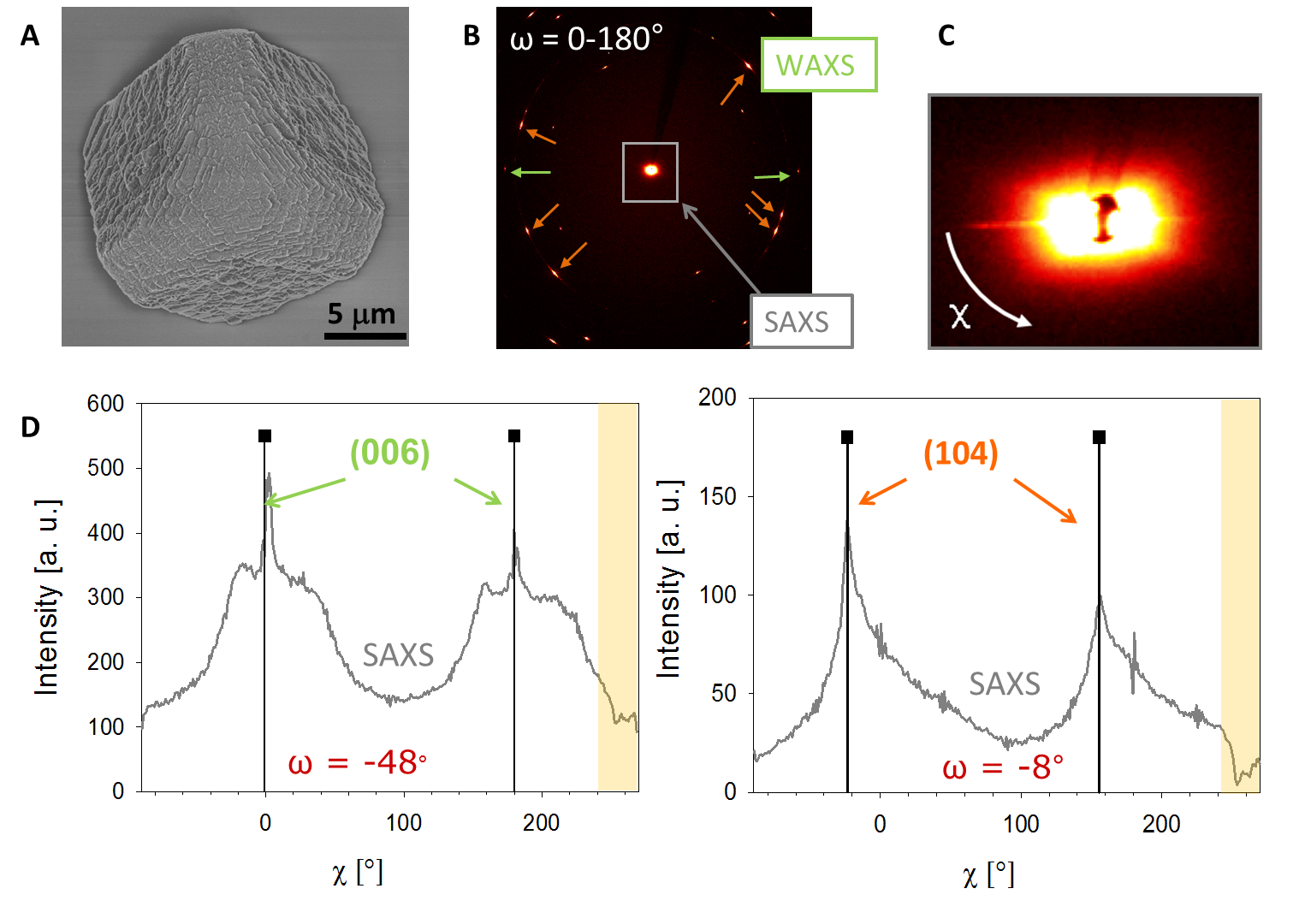Structural characterization of biogenic and bio-inspired hybrid materials
Many biominerals (e.g. bones, sea shells or glass sponges) are organic/inorganic composite materials showing hierarchical organization, i.e. they are structurally optimized at several length scales ranging from the macroscopic down to the molecular scale. Despite drawing on a limited pool of available elements, Nature has developed sophisticated mechanisms to fabricate nanostructured minerals under environmental conditions.
Not only are biogenic minerals beautifully sculptured, but their complex architectures also often lead to astounding properties adapted to suit a specific function (Figure 1). Therefore, the study of biominerals has inspired a huge body of biomimetic research aimed at a translation of their intriguing structural and functional (e.g. mechanical, optical, magnetic) properties into artificial systems.

Figure 1: Comparison between calcitic materials of geological (A) and biological (B, C) origin. The sea urchin spine (B, right) exhibits a porous microstructure with curved surfaces (C) despite diffracting x-rays almost like a single crystal of calcite.
In order to study the structure of biological and synthetic materials with complex architectures at all relevant length scales ranging from the macroscopic down to the atomic level, the group uses a combination of complementary analytical techniques including small- and wide-angle x-ray scattering (SAXS and WAXS) at laboratory instruments and synchrotron facilities, as well as electron microscopy (SEM and TEM) and vibrational spectroscopy (e.g. Raman microscopy). Using synchrotron x-ray scattering approaches in combination with imaging techniques we have previously studied the hierarchical structure (Figure 2) of synthetic calcite crystals (CaCO3) precipitated in the presence of the water-soluble polymer poly(sodium 4-styrenesulfonate) (PSS).

Figure 2: Comparison between calcitic materials of geological (A) and biological (B, C) origin. The sea urchin spine (B, right) exhibits a porous microstructure with curved surfaces (C) despite diffracting x-rays almost like a single crystal of calcite.
Remarkably, the interaction of the forming mineral phase with the structure-directing polyanionic additive has induced the formation of hybrid particles with mesoscale order similar to biominerals. By simultaneously recording the small- and wide-angle x-ray scattering signals of individual mineral/polymer hybrid particles at synchrotron facilities we were able to investigate orientation correlations between the nm-sized, disc-shaped intracrystalline polymer occlusions and the mineral lattice.These experiments have demonstrated that polymer incorporation into the crystalline host proceeded specifically along the neutral (104)-type and the charged (001)-type planes of the calcite lattice. In similarity with biological mineral crystals, the oriented occlusion of polymer molecules into the calcite crystal also translated into a modulation of the mechanical properties of the material.
Our future research will employ x-ray scattering techniques and electron microscopy to study the kinetics of mineralization processes.
For further information see:
- Anna S. Schenk, Igor Zlotnikov, Boaz Pokroy, Notburga Gierlinger, Admir Masic, Paul Zaslansky, Andrew N. Fitch, Oskar Paris, Till H. Metzger, Helmut Cölfen, Peter Fratzl, Barbara Aichmayer, Hierarchical Calcite Crystals with Occlusions of a Simple Polyelectrolyte Mimic Complex Biomineral Structures., Advanced Functional Materials 2012, 22 (22), 4668-4676.
- Sabine Rosenfeldt, Frank Mickoleit, Cornelius Riese, Matthias Völkl, Dirk Schüler, Anna S. Schenk, SAXS as an online tool to investigate arrangement and nanostructure of bacterial magnetosomes in Magnetospirillum gryphiswaldense, Applied Environmental Microbiology 2019, 85 (24), e01513- e0151319.
- Sabine Rosenfeldt, Frank Mickoleit, Cornelia Jörke, Joachim H. Clement, Simon Markert, Valérie Jérôme, Stephan Schwarzinger, Ruth Freitag, Dirk Schüler, René Uebe, Anna S. Schenk, Towards standardized purification of bacterial magnetic nanoparticles for future in vivo applications, Acta Biomaterialia 2020, 120, 293-303.
For a short review on biogenic and synthetic calcite crystals with intracrystalline organic occlusions see:
